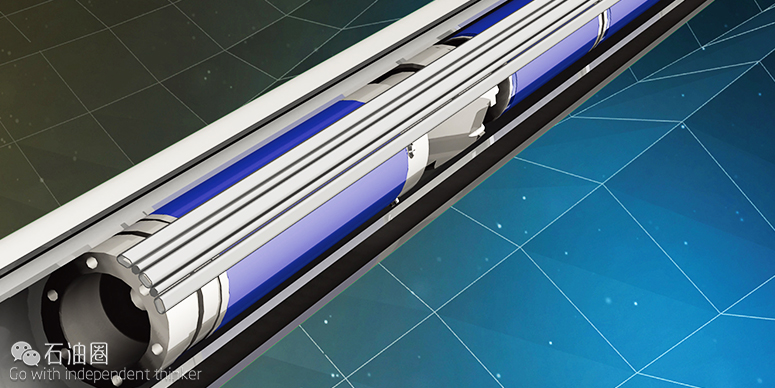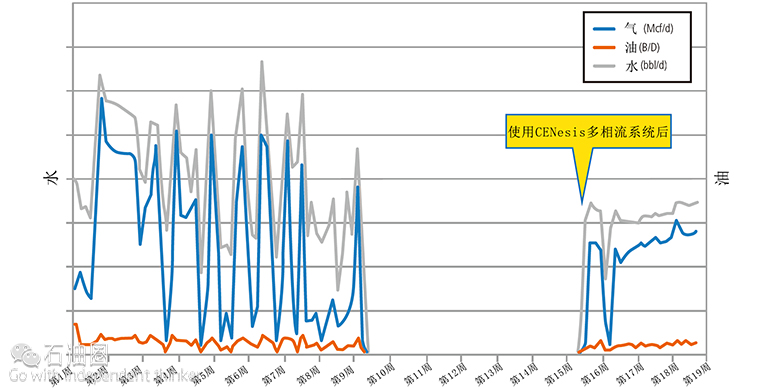CENesis PHASE Multiphase Encapsulated Production Solution
Multiphase fluid flow, which is a challenge for artificial lift systems, is nearly always present in unconventional oil resource plays. And, while horizontal wellbore construction methods do expose more reservoir to the well for greater production, they also exacerbate the unique challenges associated with producing fluids mixed with gas.
During production, as reservoir pressure depletes, natural gas is released from the reservoir and accumulates in the high side of the undulations along the horizontal lateral. When these gas accumulations—or gas slugs—break free and move up the wellbore they create low-flow or no-flow conditions in the artificial lift system.
When these conditions occur they:
- Impact system reliability due to cycling and gas lock conditions;
- Interrupt production;
- Limit ultimate reserve recovery.
Improve return on investment with a multiphase production solution that encapsulates the entire electrical submersible pumping (ESP) system in a shroud to prevent gas slugs from entering the system. The CENesis PHASE™ multiphase encapsulated production solution naturally separates gas from the production stream, which stabilizes production and eliminates reliability issues associated with pump cycling and gas lock conditions. The system design also features a patented recirculation system to ensure adequate motor cooling for even greater reliability.
The shroud provides a reservoir of fluid that allows the ESP system to continue operating when gas slugs displace fluid in the wellbore. The system design creates natural separation when the lighter natural gas continues to rise up the annulus while the heavier liquids enter the shroud to be produced through the ESP system.
During gas slug events, the integrated recirculation system keeps continuous flow moving past the ESP motor to prevent overheating. Improve production and reserve recovery By eliminating the interference of gas slugs, the CENesis PHASE solution stabilizes production rates, improves efficiency, and eliminates down time caused by system cycling and gas locking.
Through the life of the well, this continuous production profile more effectively draws down reservoir pressure to release additional hydrocarbons from the reservoir, improving ultimate reserve recovery and return on investment.
Combining a multiphase production system with unmatched gas-handling technology affords even greater operational flexibility in wells with high gas content in the fluid stream. MVP™ gas-handling systems merge a charge pump that compresses gas into solution with a primary pump designed specifically to lift multiphase fluids. AMBIT™ ESP monitoring services employing MaxRate™ gas control technology adds the last line of defense, detecting any anomalies caused by gas in the system and adjusting ESP system operating parameters to mitigate the impact.
Location: Kansas
CENesis PHASE System Increased Run Life 440% in Unconventional Well
An operator in Kansas completed a well using 7½-in. casing and in the first year of
production installed two separate standard electrical submersible pumping (ESP) systems and a gas lift system in an effort to maximize production. However, each form of artificial lift produced disappointing results. Gas lift was unable to draw down the bottomhole pressure, which limited production, and the standard ESPs experienced frequent shutdowns and high motor temperatures, resulting in deferred production and reliability issues.
Each conventional ESP system produced for several months but began to have gas interference when the pressure in the wells declined, leading to an increased number
of gas slugging incidents. The increased gas volume in the wellbore resulted in frequent gas locking of the ESP, which resulted in little to no liquid flowing past the motor and through the pump. Fluid flow is necessary to maintain an adequate operating temperature. Gas-locking events eventually led to short runs of 144 days and 102 days respectively for the first two ESP installations.
Following the short runs, the operator decided to try a gas lift solution. The gas lift system eliminated shut downs due to gas interference, but production was extremely constrained. Production with the gas lift system never exceeded 4 BOPD versus an average of 66 and 59 BOPD for the two ESP systems. The limited oil production achievable with gas lift made the well uneconomic and the operator approached Baker Hughes for an alternative ESP solution.
After evaluating the performance of previous artificial lift methods, Baker Hughes suggested the 5½-in. CENesis PHASE™ multiphase encapsulated production solution for 7-in. casing. This was the best option to decrease non-productive time (NPT) and increase the reliability and run life of the ESP system.
This was the first installation of the CENesis PHASE solution onshore and only the second installation globally.
The CENesis PHASE solution not only eliminated temperature-related shutdowns but also maximized production and run life. At the time of publication of this case history, the system had run 790 days—a 440% increase compared to the standard ESP systems.
Location: Oklahoma
CENesis PHASE System Maximized Fluid Drawdown and Increased Oil and Gas Production 19% and 43% Respectively vs. Gas Lift
An operator in Oklahoma had a well that was completed with 7?-in. casing and was using continuous gas lift as the preferred form of artificial lift. However, after 2.5 years on gas lift, the bottomhole pressure (BHP) in the well was still 683 psi. Although gas lift is stable, typically requires minimal intervention costs, and is unaffected by gas slugs in the fluid stream, it limits the bottomhole pressure draw down necessary to maximize inflow from the reservoir.
The operator recognized that the required inflow performance (IP) of the well was
greater than gas lift could provide which was constraining production. The operator
approached Baker Hughes for a reliable alternative artificial lift solution.
After evaluating the well conditions, Baker Hughes engineers determined that an electrical submersible pumping (ESP) system was the best solution to effectively draw down the bottomhole pressure to increase production and reserve recovery. However, the high gas content in the production stream was a serious consideration for the ESP system design.
Based on the production parameters, Baker Hughes and the operator determined that the CENesis PHASE™ multiphase encapsulated production solution for 7-in. casing was the best option to maximize the well’s performance and to optimize ESP system reliability. The CENesis PHASE system design encapsulates the entire ESP system
in a shroud to allow natural separation of the gas before it can enter the pump. The shrouded system optimizes production and improves equipment reliability by preventing gas locking and pumpoff conditions that plague standard ESP systems in wells with gas slugging conditions. To further enhance reliability, the CENesis PHASE solution features a patented integrated recirculation system that continually pumps fluid past the ESP motor to prevent overheating in dynamic well conditions.
The CENesis PHASE multiphase encapsulated production solution maximized the inflow of the well by decreasing the bottomhole pressure from 683 psi to 150 psi. Oil and gas production increased 19% and 43% respectively and run life increased 73% compared to the average run life of a typical ESP in similar downhole conditions.
Location: Oklahoma
Slim-line CENesis PHASE System Eliminated Shutdowns and Non-productive Time
An operator in Oklahoma had a well that was completed using 5?-in. casing and was equipped with a standard electrical submersible pumping (ESP) system. After several months on production, the pressure in the well declined, releasing gas slugs from the reservoir into the wellbore. The gas slugs created a situation in which no fluid was moving past the motor for long periods of time, causing cycling and daily ESP system shutdowns due to motor overheating.
The repeated cycling and system shut downs reduced the daily production rate from the well and negatively impacted well economics. Plus, motor overheating and repeated shutdowns can be detrimental to ESP system longevity.
After evaluating the well conditions, the Baker Hughes engineering team determined that the CENesis PHASE™ multiphase encapsulated ESP system for smaller casing sizes was the best option to solve the gas slugging issue. The system design encapsulates the pump for natural separation of the gas to prevent pumpoff conditions and recirculates fluid past the motor to prevent overheating.
The system also features the newest addition to the FLEXPump™ series pump line. The 300 series FLEXPump6 pump is the industry’s first slim-line, mixed-flow pump design, which significantly improves gas and solids handling in smaller cased wells. The FLEXPump6 design covers a flow range from 20 B/D to 800 B/D.
In addition to the new pump, the system includes an optimized motor design to improve reliability in smaller casing sizes.
The CENesis PHASE system completely eliminated cycling and shutdowns associated with gas slugs as well as mitigated potential reliability concerns due to elevated motor temperatures. By eliminating non-productive down time, the system steadied the production rate and improved the operator’s well economics.
Location: Texas
Production Enrichment Solution Improves Daily Oil Production 34%, Mitigates Non-productive Time
An operator in the Eagle Ford shale in Texas was installing rod lift systems in four wells completed with 5 ½-in., 20-lb. casing that were no longer free flowing. However, after three installations it was clear that the rod lift systems were not effectively drawing down the wells, which limited production. Fluid levels in the three wells on rod lift remained at just 600 to 1,110 ft below the surface. Plus, the three wells were experiencing repeated rod-wear failures due to the deviated wellbore geometry. The wells averaged 9,200 ft total vertical depth and 17,000 ft total measured depth.
To achieve greater drawdown, Baker Hughes engineers recommended the slim-line CENesis PHASE™ multiphase encapsulated electrical submersible pumping (ESP) system in concert with a chemical injection program using a capillary tube to prevent scale buildup in the ESP system. Based on calculations from the Baker Hughes AutographPC™ sizing and simulation software, free gas in the fluid steam was approximately 85%.
The CENesis PHASE system was also chosen as the best technical solution due to the low water cuts and high API gravity of the oil in the Eagle Ford. This combination causes the oil and gas to foam up instead of cleanly separating and it can cause the ESP system motor to overheat. The CENesis PHASE design mitigated this concern by diverting fluid past the motor to keep it cool.
By deploying a total production solution that combined the ESP system with scale and
corrosion treatment via a capillary tube, the operator and Baker Hughes were able to design a commercial model that included an environmental warranty, which expands the coverage on the ESP system to issues related to scale buildup or corrosion. With a properly designed capillary tube and chemical program, the warranty also was expanded to include any plugging, cracking, or stress to the capillary tube due to incompatible chemicals. This commercial approach, which can only be offered if Baker Hughes production experts are providing the ESP system and the chemical treatment program as a total solution, gave the operator greater confidence in the challenging conditions associated with producing from the Eagle Ford shale.

 石油圈
石油圈



